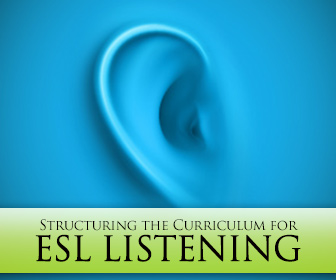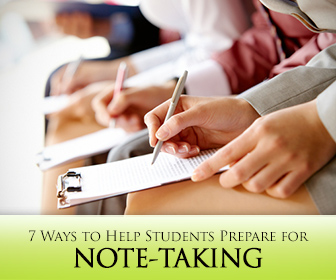What Do We Even Do All Term (or All Day)?: How to Structure the Curriculum for ESL Listening


Fortunately, as teachers, we can help students to develop meaningful listening and writing strategies for note-taking by creating appropriate practice opportunities. Here are some of the important things to address when building this skill in the academic ESL classroom:

The organization of ideas varies across cultures, and English as a Second Language students will need to become familiar with how ideas are presented in English-speaking countries in order to know how to listen for information most effectively. While they need to be made aware that there’s no absolute blueprint for how information is presented, students will benefit from being able to anticipate the placement of main ides and details in the rhetorical conventions they will likely encounter.
Pulling from any prior knowledge that students’ may have about reading and writing will expedite this process; teachers should be sure to ask students what they know already about how ideas are usually presented in written texts; better yet, instructors can allow students to see written transcripts of lectures in class, enabling them to engage visually as well as aurally before relying strictly on listening.
In addition to introducing general patterns of organization, students will also benefit from exposure to common transition words that can serve as “signposts” during a lecture. Examples of these might include things like Today we I will talk about…, Now I’d like to take a look at…., Some examples of…., In other words….
Students will be better note-takers if they utilize these cues to assist them in organizing their notes. As a introductory classroom activity, students can first listen to lectures for the sake of noticing these guide words, without worrying about content right away. Instructors can ask students to identify ones that stand out or ask them to brainstorm ahead of time what some may be and discuss what they signal. Having students practice using these transitional phrases in guided speaking activities can also reinforce their acquisition.
Many students mistakenly believe that they should try to write down everything they hear in a lecture, word-for-word. Not only is this nearly impossible, but it will greatly reduce students’ comprehension of key ideas. Instead, they will need to practice identifying the most important ideas, writing down the key points. Showing students sample notes as a model can be a helpful way to introduce this concept.
Good note-takers know how to use abbreviations as short-cuts while listening to a lecture in order to be able to record as much information as possible. Teachers can get students started by giving them a list of common abbreviations to serve as examples. From there, students should brainstorm their own. It’s important to emphasize that there’s no right way to create shortened versions of words; the only thing that matters is that students can go back to notes later and make sense of what they’ve written.
Successful listeners engage in pre-listening strategies to familiarize oneself with the topic at hand. Instructors should provide written texts, pictures, and discussion questions related to the lecture’s content before listening. This will allow learners to grow comfortable with the topic that they will be learning about. Ideally, students will be invited to create questions, just as they would when preparing to read a text. When students are listening for specific information, they have a meaningful goal that will hopefully increase the level of attention that they give to the lecture.
If possible, new and especially difficult vocabulary can be previewed, though students should also be encouraged to use context clues to determine the meaning of unfamiliar words while they listen. As a follow up to practice lectures used in class, it’s helpful to have students answer questions about this vocabulary, the purpose of which is twofold: students will hopefully acquire new vocabulary as a result of repeated exposure to words, and as a result, their comprehension of the lecture will increase.
In-class practice note-taking sessions will undoubtedly involve listening to the same lecture multiple times. A productive lesson will include pre-listening activities, an opportunity to listen to a lecture two or three times while taking guided notes, and follow-up comprehension and discussion questions. In between listenings, students can compare answers to comprehension questions. They can then listen again, knowing which answers are correct, which will give them a target piece of information to listen for.
As students develop their own personalized note-taking strategies, the classroom is a wonderful place for them to learn and improve by working with their peers. After students have listened to a lecture, they can compare notes with classmates in partners or small groups to check for consistent main ideas and details, to see how others organize their notes, and to get new ideas for abbreviations.
To facilitate these comparisons among peers, the instructor should create a checklist of items for the students to evaluate when going over their notes. This can include things like clarity of handwriting, abbreviations, use of underlining, margins, and indentations.
It is an essential component of most university courses, and therefore, any student who is preparing for academic study will want to hone their skills in this area. Like anything we teach in the ESL classroom, the purpose of note-taking should be emphasized in order to make the learning experience meaningful for students. Helping students to see note-taking as part of a process is imperative to setting them up for success. Students need to understand the importance of preparation for a lecture, know how to efficiently record information in writing, and be able to refer back to what they have written in a meaningful way that allows them to apply what they have learned and study for tests.